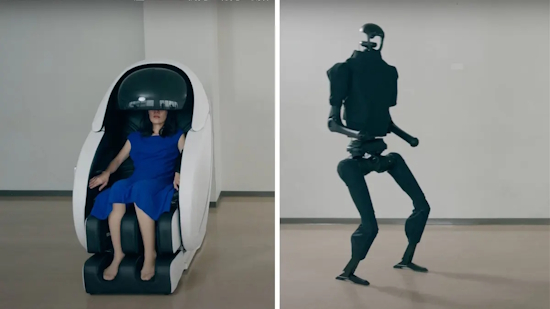[The Japanese company H2L has developed a new telepresence system that not only transmits the human user’s movements but their muscle activity and force, which “preserves force awareness, improving haptic authenticity and a sense of embodiment.” The original version of the Interesting Engineering story below about H2L’s “Capsule Interface” includes the company’s short demonstration video (which is also available on YouTube) and a second longer video about “How Biomimicry is Revolutionizing Robotics.” –Matthew]

[Image: Screenshots from the H2L video show a woman using the Capsule Interface to control a Unitree H1 humanoid robot.]
Video: Japan’s new tech turns your body into a remote control for humanoid robots
H2L’s Capsule Interface uses muscle sensors to capture real-time intent and force by detecting subtle shifts in muscle movement.
By Jijo Malayil
June 23, 2025
A Japanese technology startup has developed a new device to transmit full-body movements and physical strength.
H2L’s “Capsule Interface” technology aims to create immersive shared experiences between humans, robots, and avatars, opening new remote interaction and collaboration possibilities.
Like a massage chair, the advanced control system transforms the user’s body into a remote interface for operating a humanoid robot. The Tokyo-based company has released a short video showcasing the new system’s functions.
In May 2025, Stanford and Simon Fraser universities researchers developed TWIST, an AI system enabling humanoid robots to accurately mimic human movements in real time.
Embodied remote control
In the clip shared by H2L, a woman remotely controls a Unitree Robotics H1 humanoid robot using the Capsule Interface.
The robot’s activities demonstrate the system’s capacity to communicate precise body movements and strength, including cleaning, lifting a box, and interacting with another person.
H2L uses sophisticated muscle displacement sensors in its Capsule Interface to identify even the smallest changes in muscle tension. The technology records a user’s physical intent and applied force in real time by monitoring even the smallest changes in muscle movement, not only limb position.
This contrasts with conventional teleoperation, which usually relies on motion sensors to mimic user movements, such as IMUs [Inertial Measurement Units], exoskeletons, or optical trackers.
H2L argues that motion data alone lacks the nuance needed for emotional and physical realism. While visual and positional synchronization can create a basic sense of operation, they fail to replicate the forces exerted or the effort experienced during interaction.
By mapping real-time muscle activity directly onto a humanoid robot, the Capsule Interface preserves force awareness, improving haptic authenticity and a sense of embodiment.
This muscle-centric approach allows robots to more faithfully echo not just what a user does, but how hard they do it—lifting a heavy object, for instance, transmits how much effort the user feels. That feedback loop is essential; studies show empathy and immersion improve when users experience movement and force.
As H2L envisions it, teleoperation becomes more than mimicry—a truly shared, visceral interaction.
Human-machine synergy
The Capsule Interface introduces a new era of remote interaction by enabling users to transmit their full-body movements and physical force to robots or avatars while seated or lying down.
The gadget, which is outfitted with speakers, a display, and muscle displacement sensors, uses minute changes in muscle movement to communicate intent and effort in real time.
The Capsule Interface provides a low-effort, natural experience that can be incorporated into beds or chairs, unlike standard interfaces that require complicated equipment or specific training.
According to an H2L statement, the versatile technology has a wide range of applications. In business, users can attend meetings or handle tasks at distant locations without travel, operating humanoid robots from home or nearby offices.
Delivery workers can lift and carry items remotely, reducing physical strain. It also enables safe teleoperation in hazardous environments such as disaster zones.
The method helps dual-income families, the elderly, and everyday home tasks like cooking and cleaning. Agricultural robots can be controlled remotely by farmers, who can exchange knowledge to reduce labor needs.
Additionally, the interface facilitates immersive avatar communication in virtual environments, creating new opportunities in healthcare, entertainment, and education. In the future, H2L intends to add proprioceptive feedback, increasing realism and broadening the range of shared experiences between people and machines.
Leave a Reply